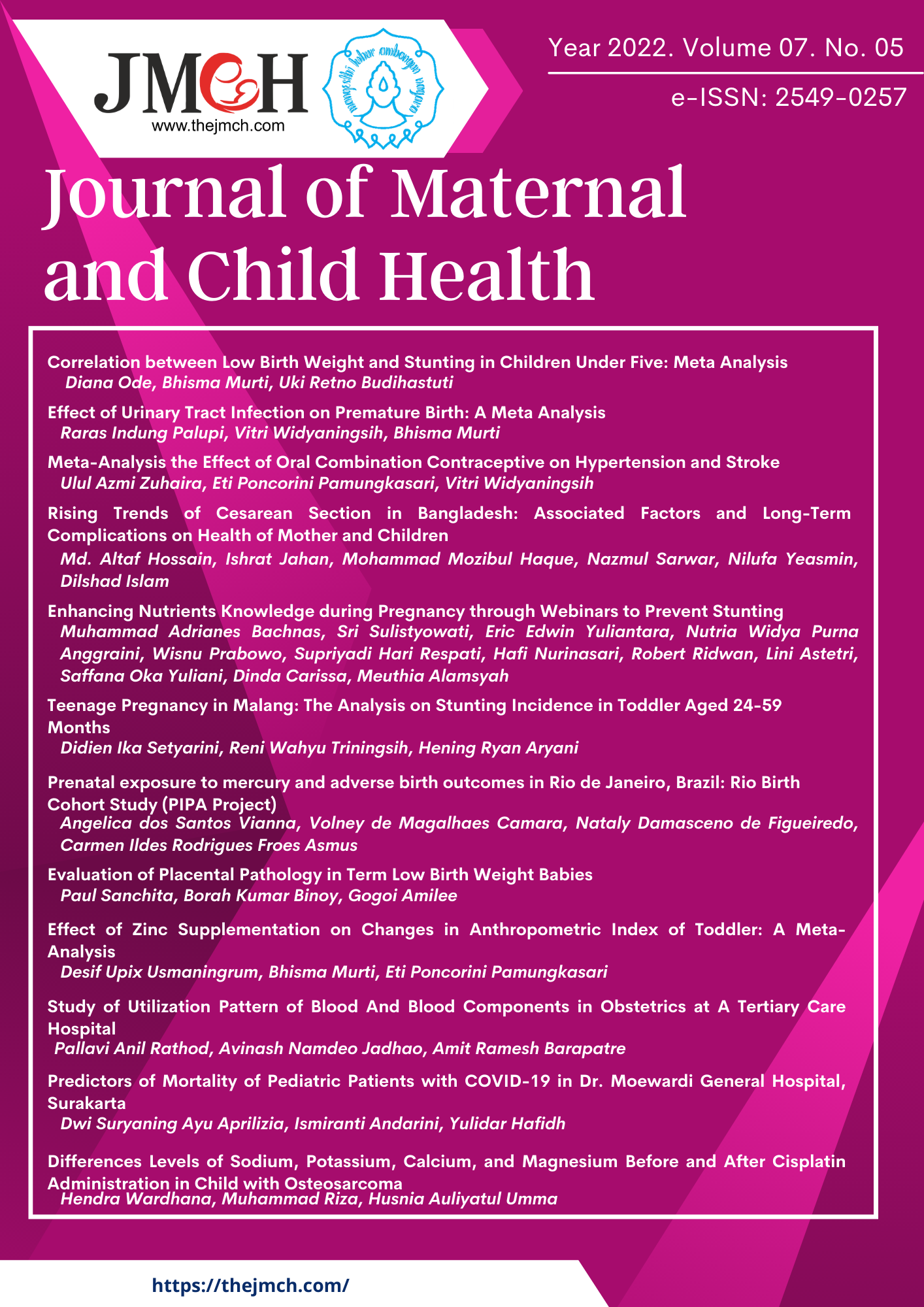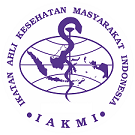Rising Trends of Cesarean Section in Bangladesh: Associated Factors and Long-Term Complications on Health of Mother and Children
DOI:
https://doi.org/10.26911/thejmch.2022.07.05.04Abstract
Background: With taking into consideration of the high cesarean section (CS) rate, the objectives of this study were to ascertain factors associated with and point out metamorphose complications with high CS rates in Bangladesh.
Subjects and Method: A cross-sectional study accounted for data collection from rural (196) and urban (241) women who gave birth to babies between 2005 and 2018 in Chattogram, Bangladesh. The study subjects were selected by using a systematic random sampling technique and the sample size was determined by using web-based Raosoft software. The delivery modes were dependent variables whereas influential factors and complications related to delivery were independent variables. The data were collected through face-to-face interviews using a pre-structured questionnaire. The height and weight of the participants were measured by using a stadiometer and weighing machine respectively. Data analysis was done by using regression analysis.
Results: The results divulged that mingling of relative influence and doctor’s profit-making tendency, obstetric factors, and demand from a family with higher socioeconomic status contributed to the recent increased cesarean rate in urban areas (41.5%). The distended abdomen in mothers (OR= 5.11, 95% CI= 2.98 to 8.76) was strongly associated with CS (p< 0.05), and back pain, and urinary incontinence were about one and half times higher in CS mothers. However, miscarriage and pelvic organ prolapse were associated with decreased risks of CS. Postnatal complications include cold fever (OR= 11.95, 95% CI= 7.02 to 20.35), and pneumonia (OR= 5.79; 95% CI= 2.71 to 12.36) were highly prevalent in children with cesarean delivery.
Conclusion: Cesarean section has become alarmingly increased in urban rather than rural areas of Bangladesh in recent decays. Awareness-raising, doctor commitment, government policy, and strict monitoring of private health facilities are needed to control high rates of cesarean delivery.
Keywords: cesarean delivery; vaginal delivery; demographic factors; obstetric factors; postpartum complications.
Correspondence: Md. Altaf Hossain, Department of Animal Resources Science, Sunchon National University, Suncheon, Jeollanam-do, South Korea. Telephone: +8201098532108; Email: altaf@cvasu.ac.bd
References
Agudelo-Espitia V, Parra-Sosa BE, Restrepo-Mesa SL (2019). Factors associated with fetal macrosomia. Revista de Saude Publica. 53:100. doi: 10.11606/s15188787.2019053001269.
Ahmmed F, Manik MMR, Hossain MJ (2021). Caesarian section (CS) delivery in Bangladesh: A nationally representative cross-sectional study. PLOS ONE 16(7): e0254777. https://doi.orgAgudelo-Espitia V, Parra-Sosa BE, Restrepo-Mesa SL (2019). Factors associated with fetal macrosomia. Revista de Saude Publica. 53:100. doi: 10.11606/s15188787.2019053001269.
Ahmmed F, Manik MMR, Hossain MJ (2021). Caesarian section (CS) delivery in Bangladesh: A nationally representative cross-sectional study. PLOS ONE 16(7): e0254777. https://doi.org/10.1371/journal.pone.0254777
Anwar I, Sami M, Akhtar N, Chowdhury ME, Salma U, Rahman M, Koblinsky M (2008). Inequity in maternal healthcare services: evidence from homebased skilled-birth-attendant programmes in Bangladesh. Bull World Health Organ. 86(4):252-9. doi: 10.2471/blt.07.042754.
Beta J, Khan N, Khalil A, Fiolna M, Ramadan G, Akolekar R (2019). Maternal and neonatal complications of fetal macrosomia: systematic review and meta-analysis. Ultrasound Obstet Gynecol. 54(3): 308-318. doi: 10.1002/uog.20279.
Betrán AP, Merialdi M, Lauer JA, Bing-Shun W, Thomas J, Van Look P, Wagner M (2007). Rates of caesarean section: analysis of global, regional and national estimates. Paediatr Perinat Epidemiol. 21(2): 98-113. doi: 10.1111/j.13653016.2007.00786.x.
Busaidi AI, Al-Farsi Y, Ganguly S, Gowri V (2012). Obstetric and non-obstetric risk factors for cesarean section in oman. Oman Med J. 27(6):478-81. doi: 10.5001/omj.2012.114.
Cegolon L, Mastrangelo G, Maso G, Dal Pozzo G, Ronfani L, Cegolon A, Heymann WC, et al. (2020). Understanding factors leading to primary cesarean section and vaginal birth after cesarean delivery in the friulivenezia giulia region (North-Eastern Italy), 2005-2015. Scientific Reports. 10(1):380. doi: 10.1038/s4159801957037y.
Diana V, Tipandjan A (2016). Emergency and elective caesarean sections: comparison of maternal and fetal outcomes in a suburban tertiary care hospital in Puducherry. Int J Reprod, Contracep, Obstet and Gynecol. 5(9): 3060–3065. doi: http://dx.doi.org/10.18203/23201770.ijrcog20162985.
Dorji T, Wangmo K, Dorjey Y, Dorji N, Kiran Chhetri D, Tshering S, Wangmo P, et al. (2021). Indications and factors associated with cesarean section in Bhutan: A hospital-based study. Int. J. Gynaecol Obstet. 153(3): 520-526. doi: 10.1002/ijgo.13506.
Farzana T, Kabir J (2014). A Comparative Study on the Preference for Delivery Process in Bangladesh. ABC J Adv Res. 3(1): 24-28. doi: 10.18034/abcjar.v3i1.28.
Feng XL, Xu L, Guo Y, Ronsmans C (2012). Factors influencing rising caesarean section rates in China between 1988 and 2008. Bulletin of the World Health Organization. 90(1): 30-9, 39A. doi: 10.2471/BLT.11.090399.
Gondwe T, Betha K, Kusneniwar GN, Bunker CH, Tang G, Simhan H, Reddy PS, et al. (2019). Maternal factors associated with mode of delivery in a population with a high cesarean section rate. Journal Epidemiol Glob Health. 9(4): 252-258. doi: 10.2991/jegh.k.191017.001.
Hasan F, Alam MM, Hossain MG (2019. Associated factors and their individual contributions to caesarean delivery among married women in Bangladesh: Analysis of Bangladesh demographic and health survey data. BMC Pregnancy Childbirth. 19, 433. doi: https://doi.org/10.1186/s1288401925889.
Hou X, Rakhshani NS, Iunes R (2014). Factors associated with high Cesarean deliveries in China and Brazil - A Call for reducing elective surgeries in moving towards Universal Health Coverage. J Hosp Adm. 3: 67. doi: 10.5430/jha.v3n5p671
Islam MM, Islam MK, Hasan MS, Hossain MB (2017) Adolescent motherhood in Bangladesh: Trends and determinants. PLoS ONE 12(11): e0188294. doi: https://doi.org/10.1371/journal.pone.0188294
Islam MM, Noor FM (2021). Prevalence and factors of cesarean delivery among Bangladeshi reproductive aged women: evidence from multiple Indicator cluster survey 2019 data. Journal of Public Health. 1–10. doi: https://doi.org/10.1007/s10389021015519
Kamal SM (2013). Preference for institutional delivery and caesarean sections in Bangladesh. J. Health Popul Nutr, 31(1): 96-109. doi: 10.3329/jhpn.v31i1.14754.
Keag OE, Norman JE, Stock SJ (2018). Longterm risks and benefits associated with cesarean delivery for mother, baby, and subsequent pregnancies: Systematic review and meta-analysis. PLoS Medicine. 15(1): e1002494. doi: 10.1371/journal.pmed.1002494.
Kotsev S (2011). Ogilvie's syndrome following cesarean delivery: The Dubai's case. Saudi journal of anaesthesia. 5(3), 335-338. doi: https://doi.org/10.4103/1658-354X.84117.
Kulas T, Bursac D, Zegarac Z, Planinic-Rados G, Hrgovic Z (2013). New views on cesarean section, its possible complications and longterm consequences for children's health. Medical Archives. 67(6):460-463. doi: 10.5455/medarh.2013.67.460-463.
Lee HC, Gould JB, Boscardin WJ, El-Sayed YY, Blumenfeld YJ (2011). Trends in cesarean delivery for twin births in the United States: 1995-2008. Obstetrics and Gynecology. 118(5):1095-1101. doi: 10.1097/AOG.0b013e3182318651.
Leone T, Padmadas SS, Matthews Z (2008). Community factors affecting rising caesarean section rates in developing countries: an analysis of six countries. Soc Sci Med. 67(8):1236-46. doi: 10.1016/j.socscimed.2008.06.032.
Mascarello KC, Horta BL, Silveira MF (2017). Maternal complications and cesarean section without indication: systematic review and meta-analysis. Rev Saude Publica. 51:105. doi: 10.11606/S15188787.2017051000389.
Miller JE, Goldacre R, Moore HC, Zeltzer J, Knight M, Morris C, Nowell S, et al. (2020). Mode of birth and risk of in-fectionrelated hospitalisation in childhood: A population cohort study of 7.17 million births from 4 high-income countries. PLoS Medicine. 17(11): e1003429. doi: 10.1371/journal.pmed.1003429.
Moore HC, de Klerk N, Holt P, Richmond PC, Lehmann D (2012). Hospitalisation for bronchiolitis in infants is more common after elective caesarean delivery. Arch Dis Child. 97(5):410-4. doi: 10.1136/archdischild2011300607.
Nazir S (2015). Determinants of cesarean deliveries in Pakistan. PIDE Working Papers. 122: 1-16.
Rahman M, Ahmad Shariff A, Shafie A, Saaid R, Md Tahir R (2014). Determi-nants of caesarean risk factor in nort-hern region of Bangladesh: a multiva-riate analysis. Iranian journal of public health. 43(1): 16-27.
Rahman MM, Haider MR, Moinuddin M, Rahman AE, Ahmed S, Khan MM (2018). Determinants of caesarean section in Bangladesh: cross-sectional analysis of Bangladesh demographic and health survey 2014 data. PLoS ONE 13(9): e0202879. https://doi.org/10.1371/journal.pone.0202879.
Sandall J, Tribe RM, Avery L, Mola G, Visser GH, Homer CS, Gibbons D, et al. (2018). Short-term and longterm effects of caesarean section on the health of women and children. Lancet. 392 (10155):1349-1357. doi: 10.1016/S01406736(18)319305.
Shabnam S (2016). Caesarean section deli-very in India: causes and concerns.
Shahabuddin AS, Delvaux T, Utz B, Bardají A, De Brouwere V (2016). Determi-nants and trends in health facility-based deliveries and caesarean sections among married adolescent girls in Bangladesh. BMJ Open. 6(9):e012424. doi: 10.1136/bmjopen-2016-012424.
Sheiner E, Levy A, Feinstein U, Hallak M, Mazor M (2002). Risk factors and outcome of failure to progress during the first stage of labor: a population-based study. Acta Obstetricia et Gynecologica Scandinavica. 81(3):222-6.
Sikder SS, Labrique AB, Ali H, Hanif AA, Klemm RD, Mehra S, West KP Jr, et al. (2015). Availability of emergency obstetric care (EmOC) among public and private health facilities in rural northwest Bangladesh. BMC Public Health. 15:36. doi: 10.1186/s12889-015-1405-2.










